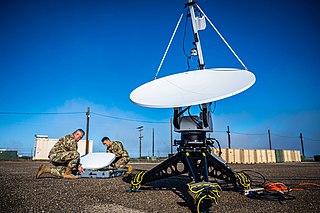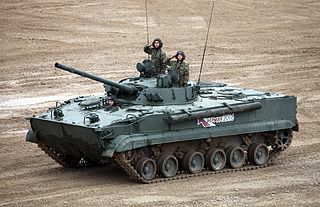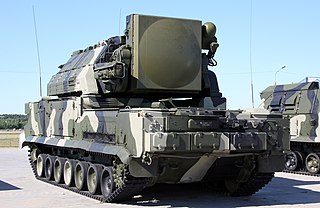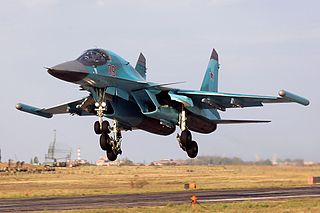
Electromagnetic warfare or electronic warfare (EW) is warfare involving the use of the electromagnetic spectrum or directed energy to control the spectrum, attack an enemy, or impede enemy operations. The purpose of electromagnetic warfare is to deny the opponent the advantage of—and ensure friendly unimpeded access to—the EM spectrum. Electromagnetic warfare can be applied from air, sea, land, or space by crewed and uncrewed systems, and can target communication, radar, or other military and civilian assets.

The Russian Airborne Forces is the airborne forces branch of the Russian Armed Forces. It was formed in 1992 from units of the Soviet Airborne Forces that came under Russian control following the dissolution of the Soviet Union.

The BMP-3 is a Soviet and Russian infantry fighting vehicle, successor to the BMP-1 and BMP-2. The abbreviation BMP stands for Boevaya Mashina Pekhoty.

Power projection in international relations is the capacity of a state to deploy and sustain forces outside its territory. The ability of a state to project its power into an area may serve as an effective diplomatic lever, influencing the decision-making processes and acting as a potential deterrent on other states' behavior.

The Tor is an all-weather, low-to medium-altitude, short-range surface-to-air missile system designed for destroying airplanes, helicopters, cruise missiles, unmanned aerial vehicles and short-range ballistic threats (anti-munitions). Originally developed by the Soviet Union under the GRAU designation 9K330 Tor, the system is commonly known by its NATO reporting name, SA-15 "Gauntlet". A navalized variant was developed under the name 3K95 "Kinzhal", also known as the SA-N-9 "Gauntlet". Tor was designed to shoot down guided weapons like the AGM-86 ALCM and BGM-34 day and night, in bad weather and jamming situations. Tor can detect targets while on the move. The vehicle must stop intermittently when firing, although trials have been conducted with the goal of eliminating this restriction.

The Mil Mi-17 is a Soviet-designed Russian military helicopter family introduced in 1975 (Mi-8M), continuing in production as of 2021 at two factories, in Kazan and Ulan-Ude. It is known as the Mi-8M series in Russian service. The helicopter is mostly used as a medium twin-turbine transport helicopter, as well as an armed gunship version.

JSC Rosoboronexport is the sole state intermediary agency for Russia's exports/imports of defense-related and dual use products, technologies and services. The Rosoboronexport Federal State Unitary Enterprise (FSUE) was set up in 2000 by a Decree of the President of Russia and is charged with implementation of the policy of the State in the area of military-technical cooperation between Russia and foreign countries. In 2007, the enterprise was re-registered as Rosoboronexport Open joint-stock company (OJSC). In 2011, Rostekhnologii non-profit state corporation acquired 100% of Rosoboronexport OJSC.

The 9K720 Iskander is a mobile short-range ballistic missile system produced and deployed by the Russian military. They travel at a terminal hypersonic speed of 2100–2600 m/s and can reach an altitude of 50 km as they range up to 500 km. The missile systems (Искандер-М) were intended to replace by 2020 the supposedly-obsolete OTR-21 Tochka systems in the Russian military.

The Russian 201st Military Base is a Russian military base based in Dushanbe, Tajikistan, part of the Central Military District. It was originally raised twice in World War II as part of the Soviet Union's Red Army and is now part of the Russian Ground Forces.

TOS-1 Buratino is a Soviet 220 mm 30-barrel or 24-barrel multiple rocket launcher capable of using thermobaric warheads, mounted on a T-72 / T-90 tank chassis. TOS-1 was designed to attack enemy fortified positions and lightly armored vehicles and transports, particularly in open terrain. The system’s first combat tests took place in 1988 and 1989 in the Panjshir Valley during the Soviet–Afghan War. The TOS-1 was shown for the first time in public in 1999 in Omsk.

The Tigr is a Russian 4×4 multipurpose all-terrain infantry mobility vehicle manufactured by Military Industrial Company, first delivered to the Russian Army in 2006.

Rostec, formally trading as State Corporation "Rostec", fully the State Corporation for the Promotion of the Development, Manufacture, and Export of High Tech Products "Rostec" and formerly Rostekhnologii, is a Russian state-owned defense conglomerate headquartered in Moscow.

Ratnik is a Russian future infantry combat system. Some components, including the communication systems and night vision technologies, have extremely limited military distribution. It is designed to improve the connectivity and combat effectiveness of combat personnel in the Russian Armed Forces. Improvements include modernised body armour, a helmet with a special eye monitor, communication systems, and special headphones. It includes 10 subsystems and 59 individual items.

Khibiny (L-175V) (Хибины) (Л-175В) is Soviet / Russian aircraft electronic countermeasures (ECM) system. The name refers to Khibiny Mountains.

The Krasukha is a Russian mobile, ground-based, electronic warfare (EW) system. This system is produced by the KRET corporation on different wheeled platforms. The Krasukha's primary targets are airborne radio-electronics and airborne systems guided by radar. The Krasukha has multiple applications in the Russian Armed Forces.

United Instrument Manufacturing Corporation or UIMC was a Russian state-owned company, which was founded in March 2014 within state corporation Rostec as a specialized management company uniting research and production enterprises of radioelectronic industry of Russia. Rostec owned 9.3% of the shares as of April 2015. The company merged with Ruselectronics in February 2017.
KORAL is a land-based transportable electronic warfare system developed to jam and deceive hostile radars of enemy nations.

International Military-Technical Forum "Army" is an event organized by the Ministry of Defense of the Russian Federation. It includes special projects, such as International Exhibition of High-Performance Equipment and Technologies for the Rearmament of Defense Enterprises "Intelligent Industrial Technologies" and the specialized exhibition "Innovation Club".

















